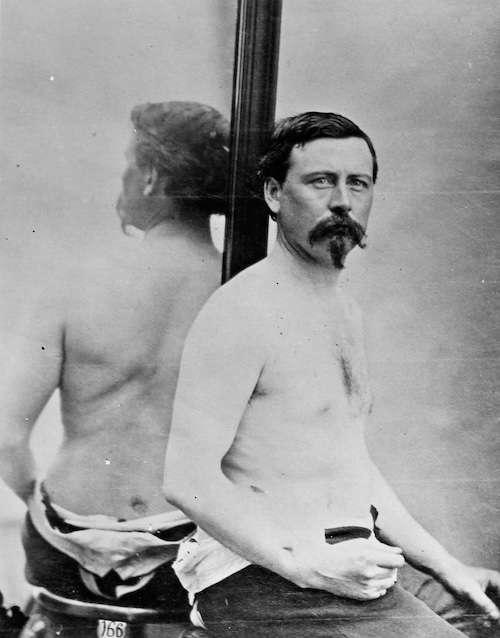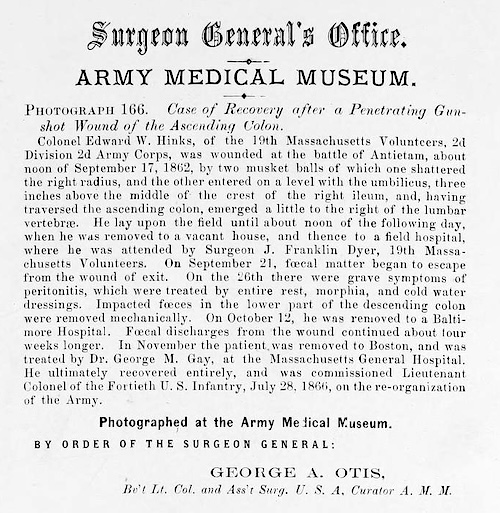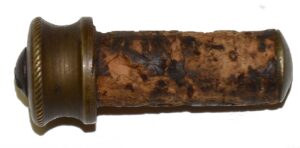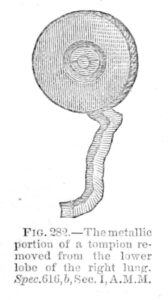Brig. Gen. E.W. Hincks (c. 1865)
3 December 2024

PHOTOGRAPH 166. Case of Recovery after a Penetrating Gunshot Wound of the Ascending Colon.
Colonel Edward W Hincks, commanding the 19th Massachusetts Infantry, was severely wounded at about noon on 17 September 1862 at Antietam. He was hit by a bullet that went through his right forearm, then through his body, exiting very near his spine.
A gunshot through the abdomen was almost invariably fatal in that era, but Hincks survived to serve through the war as a Brigadier General of Volunteers, and afterward, to retirement in 1870, as a Lieutenant Colonel in the Regular Army.
Here he is, in his Colonel’s uniform, with his wife* in a photograph taken in Boston, probably before his Antietam experience.

Notes
* I’m guessing this picture was taken about May 1861 when he was appointed Colonel, but almost certainly before March 1863 when he was promoted to Brigadier General. In which case, the woman in the picture is probably his first wife, Ann Rebecca “Annie” Dow (c. 1838-August 1862, m. 1855). The Library of Congress identifies her as his second wife Elizabeth Pierce Nichols (1842-1890), but she married Edward in Cambridge in September 1863 – long after he was appointed Brigadier General. I’ve asked the archivists at the Library of Congress if there’s any more information about that identification. I’ll update you if I hear.
Below is his medical case history in a page posted to the back of that photograph at the top of the page, its text largely taken from the Medical and Surgical History of the War of the Rebellion. The original narrative in the MSHWR, though, says all that damage was made by one bullet.

Both the case history and the photograph at the top are from Volume 4 of Photographs of Surgical Cases and Specimens published by the Office of the Surgeon General of the Army sometime after 1870. It’s online from the Internet Archive.
The photograph of General Hincks and his wife is from the Library of Congress.
Death by tompion
29 November 2024
Tompion: a plug pushed into the muzzle of a rifle to keep out dirt and water.

This example, probably for an English-made Enfield model of 1853, made of brass and cork, was sold by the Horse Soldier in Gettysburg.
The soldier’s culpable negligence in failing to remove the tompion before firing, resulted sometimes in the bursting of the piece; sometimes in the projection of the tompion with sufficient force to penetrate, within short range, a man’s body; almost always, unfortunately, in more injury to others then to himself. The following is one of those cases …
Private George Meyers of the 13th New Jersey Infantry was accidentally wounded by a comrade’s tompion at Antietam on 17 September 1862 and he died in a hospital in Philadelphia about a month afterward.
Here are the woodcut illustrations which accompany the description of Private Meyer’s somewhat unusual case in the Army Surgeon General’s Medical and Surgical History of the War of the Rebellion (1870-1883).
It occurs to me that the outcome might not have been much different if the man in the rank behind poor George had removed his tompion …
Thomas E. Sims (c. 1862)
27 November 2024
17 year old farm boy Thomas E Sims enlisted as a Private in the Orange Guards – Company G of the 27th North Carolina Infantry – in March 1862. Which is probably when this photograph was taken.
He survived the terrible combat at Sharpsburg in September that year but was mortally wounded in a little known skirmish at Gary’s Farm near Richmond, VA on 15 June 1864. Captain John Sloan of Company B later described the action there:
Our brigade, as yet, in the swamps of the Chickahominy, was almost daily employed in skirmishes with the enemy’s cavalry. On the 15th of June we came across a large force of cavalry at Gary’s farm. They had met a small force of our cavalry and had been driving them. When we arrived they dismounted and sent their horses to the rear, formed their lines and showed fight. After a sharp struggle their lines gave way, and we pursued them some distance through the woods. Their sharpshooters were armed with seven shooters, and they used them against us on our advance with telling effect. When they reached their horses they quickly remounted and were soon beyond our reach.
Young Thomas was taken to the Camp Winder hospital in Richmond and died there the next day, 19 years old.
Notes
This compelling photograph of him is from the Vanatos Archive, shared to his memorial on Findagrave.
John A Sloan’s narrative, based on his wartime notes, was published in his Reminiscences of the Guilford Grays, Co. B, 27th N.C. Regiment (1883).




